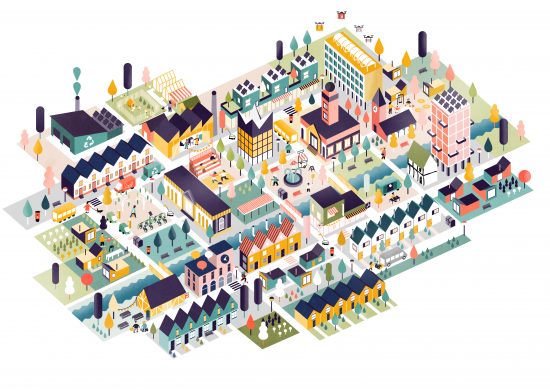ShareTown is a fictional town populated by a cast of characters, which sets out to create a positive vision of what a preferred future for cities might be. Community needs are attained in ShareTown through self-organization, as well as democratic and inclusive growth. A new relationship between citizens and local governments emerges in this new and unique digital world.
“We decided to be radically optimistic and focus on a preferred future, in which those ideas that are currently emerging at the edges have become the norm.”
What inspired the project and how did it grow?
Global innovation foundation Nesta, has been examining the collaborative economy and its impacts since 2013. Over this time, the narrative of the altruistic sharing economy has developed to surface less positive aspects. However, Nesta believes there is significant potential for platforms to be directed towards addressing social needs.
We’ve used two routes to test how platform technology can be put to work for social benefit:
- what platforms can be built to do and for whose benefit;
- how the organisations that use platforms to deliver their services are owned and operated.

We created the ShareLab Fund to test and explore the new paradigm. Since 2016 Nesta’s Sharelab Fund has awarded 19 grants to early stage innovators who are building platforms which address a broad range of social needs including homelessness, transport poverty, community energy, and social care. We’re also working with a consortium of partners to explore how platforms can be owned by the people who use them so they can set the rules around how they work and enjoy the value they create.
Our next step is to broaden our approach and to think more about how platforms can support places and people in their daily lives. One thing we’ve learnt through ShareLab is that technology doesn’t exist in isolation and in all innovations the way people meet their needs crosses over into the role of local government. Which is why we created ShareTown.
In this imaginary town, interactions between citizens and local government are balanced and collaborative, and data and digital platforms are deployed for public benefit rather than private gain. Here, the government plays a plurality of roles, working with local people to understand their needs, how these can best be met and by whom. Individuals and households can navigate, combine and contribute to different services and are provided with new opportunities to connect and collaborate with others.

Local government is the primary provider of numerous essential services, which make their citizens’ lives liveable on a day-to-day basis. It is the safety net for children in need of care, for those facing homelessness and those caring for the elderly. It controls housing in the rental sector, maintains local infrastructure, nurtures public green space and provides those all important bin collections and parking permits. Budget restrictions have meant losses of almost 40 percent for councils across the UK. This has had obvious consequences for services put in place to protect the vulnerable: several councils have cut their services to a statutory minimum, with more likely to follow.
This austerity narrative does not foster a creative mindset. But the changing needs of aging populations, the rapid rise of technology, changes in the way we work, impending climate crisis, combined with the ongoing pressure on funding all demand new ideas and fresh ways of looking at the options. Faced with such relentless challenges and so few resources it would be easy to feel despair.
Against this backdrop the ShareLab team wanted to find a route by which we could explore how people’s needs can be put at the centre of services, using collaborative models for organising and ownership, aided by platform technology. And to do this we decided to be radically optimistic and focus on a preferred future in which those ideas that are currently emerging at the edges have become the norm.
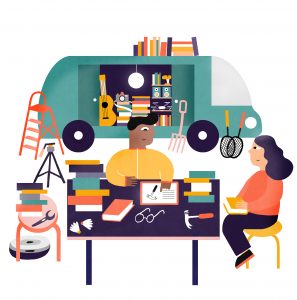
Who were your main collaborations for this project?
Our initial insights were gathered from our ShareLab grantees and also from the rise in the platform coop movement. The project was initiated about 18 months ago by Alice Casey, Head of New Operating Models at Nesta, in collaboration with our Explorations team. To help us, we commissioned Justin Pickard of Strange Telemetry, a research consultancy, who also put us in touch with illustrator Cat Finnema.
Initially, we ran internal workshops to gather ideas, but it quickly became evident that we lacked the experience of the sharp end of public service delivery. We decided we needed to recruit help from people working in local authorities, civil society and beyond. Many of the details of ShareTown and how its citizens live derive from a May 2018 workshop with leaders from local government and civil society. After identifying our criteria for a positive future for public service delivery, we looked for seeds of that future in projects and social innovations from the present, including those funded as part of the ShareLab programme.
The themes, ideas, and predictions that came up in our discussions are interwoven into the ten stories we’ve written, outlining a cast of characters involved in different scenarios taking place in different parts of the town.
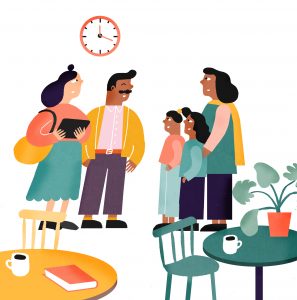
Who are ShareTown’s citizens? What type of services does it target and why?
Zoe and Max use community waste coop The Loop to pass on their unwanted furniture, toys, and appliances. In this way, bulky waste is passed into a circular economy of upcycling and reuse.
Iggy and Laura show us how fabrication spaces with 3D printers can process and reuse plastic to create useful items for people’s homes – and help people develop valuable digital making skills to contribute to the new reuse economy.
Language tutor and translator Nish shows us how the future of work will include platform-enabled freelance work, with people performing a variety of roles – and how a cooperatively owned platform might help him administrate his working life in a way that takes advantage of flexibility but avoids the precarity of the gig worker.
Gwen works from home dispatching platoons of autonomous lorries, demonstrating how people doing high-tech jobs from home will require full fibre, 5g networks and gain the flexibility to balance work with family life. Gwen’s second story illustrates parents collectivising childcare though parent-lead childcare coops – offering lower cost, higher quality care, supported by volunteering.
Laura’s sad tale suggests that professional jobs will be affected by the rise of algorithmic automation, creating precarious living conditions for the middle classes with high debt, low savings, and high-cost housing. Luckily she benefits from a social prescribing approach that sees her being helped to develop new skills by a social enterprise and offered a home in a supported co-housing unit.
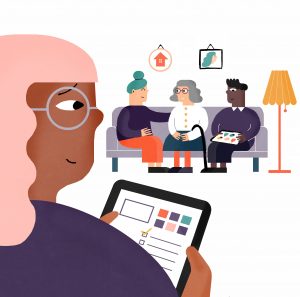
Alison the social worker and the Bluebird home care supporting Lyn through early stage dementia illustrate a move towards employee or cooperatively owned, self-managed teams delivering higher quality, lower cost social services, and social care.
The Fox and Beth’s Food Hub are based in the rise of shared ownership of community assets which then deliver social value back into the community.
And Asim shows how we could reinvent traditional services like libraries – lending things alongside books, combining the librarian’s role with community advice and support.
The town’s stories have been written on the assumptions that:
- Climate change initiated forced migration feeds the need to assimilate new citizens;
- The rise of autonomous vehicles will compromise driving jobs – and empty the streets of vehicles;
- Radical carbon reduction targets will lead to the production of renewable energy on private buildings and public spaces as a norm;
- Shared transport options and vehicle charging points will be built into city infrastructure;
- A rise in interest in local wealth building initiatives will supplement and overtake inward investment as a way to build local economies;
- Use of levers like rates and procurement policies by local government will stimulate the creation of local businesses and social enterprises using collective ownership models and effect a shift from an extractive local economy to a generative one.
The digital shift is opening new opportunities to create dialogue between public administration and citizens, what type of changes have you witnessed recently?
We see the emergence of new operating models within local authorities – small signs of new things emerging, built on a desire to do more with less, but also to realign with citizens’ changing needs.
For too long the state or the market have been seen as the only viable ways to meet people’s needs, but that misses out the opportunities provided by civil society and communities. So we want to explore how to build an ecosystem of provision across those domains that suits the needs of an individual. We think this means local authorities being able to adopt different roles. Although technology is a key driver and a key enabler, it’s not about the technology. It’s about human needs and behaviour and how institutions and the individuals within them can adapt and become more responsive to changing conditions.
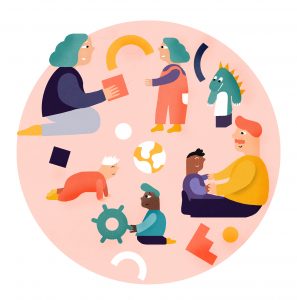
ShareTown’s reference points are existing digital platforms, is there any way to measure their impact on communities?
Many of our reference points are ShareLab grantees, who are at too early a stage to have been able to properly evaluate their social impact.
We also refer to some ideas working at scale, for instance, Buurtzorg are revolutionising social care in the Netherlands and now have 10,000 nurses, working in self-managed teams of twelve to deliver high quality health care to people in their homes. Here, the innovation is in the structure and working practices of the organisation but it is facilitated by technology. I think a key learning is that technology alone isn’t what will have the most positive impact on communities, but change is achieved with a combination of ownership, operating model and use of technology.
How can we preserve sharing economy platforms’ social value and keep them outside the grips of big tech companies?
For me that’s all about the ownership model. Cooperatively owned platforms feel like the best way to challenge platform capitalism-which is very much affected by the VC funding model. ShareLabber Equal Care Coop are a very exciting start-up which we think offers an alternative to the accepted view of platforms. If we pursue this model though, we need to understand what new funding models are necessary – and challenge expectations around growth and return on investment.
ShareTown is one of Nesta’s futurescoping projects tackling future challenges by supporting emerging technologies. Which are the main challenges urban planners need to be aware of in regards to digital innovations?
I think using a future time frame is a good way to ensure you don’t start with the technology but by exploring what kind of society you want that technology to enable. We don’t know exactly which technologies will take off, and which will fall by the wayside so we need to build excellent enabling infrastructure (and make sure it is equally available to all – as shown in Gwen’s story). The perfect future won’t just arrive – we need to address the problems we have now. If we don’t, our contemporary problems will remain with us and be amplified by technology. So inequality needs to be addressed in planning, along with loneliness and isolation.

Technology can play a part in this but it shouldn’t be the starting point: it’s about designing liveable places that enable communities to flourish. I would suggest that collective ownership of community assets – like pubs, village halls, green spaces – ensures not only that these places are preserved as spaces in which a community can come together, but also that local people are actively engaged in the management and use of that place.
The ownership and revenue models of key technologies are also something we should all be aware of as they affect not only the ways that technology works but also how our relationship with it will play out. So the maxim ‘if the service is free you are the product’ is very pertinent. We are used to using ‘free’ software from Google, Facebook etc. but in return, our data is being capitalised. City planners need to be clear what relationship they are entering into with technology providers and how those companies are planning to make a return. I’m also supporting and advocating for the use of open source tools and cooperatively owned platforms.
Your project is challenging dominant paradigms of social change. What can we do to shift to sharing economy and build a cooperative city?
Recognising this as a goal is a very good starting point! For too long we’ve prioritised growth as a goal and used measures like GVA to quantify that, but this doesn’t relate to how people can live good lives. A city needs basic functions that support a good life, and we need to focus on these functions.
The foundational economy is a good starting point: although I’m really interested in the Community Wealth Building initiative being implemented in Preston and Wigan in the UK. Fundamentally though I think it’s about shifting our mindsets away from inward investment to drive economic growth, and a reliance on a paternalistic state to deliver one size fits all services. We need instead to build an ecosystem that focuses on creating a state of human flourishing – what the ancient Greeks termed Eudaimonia. But one that also fits within the capacity of the planet.
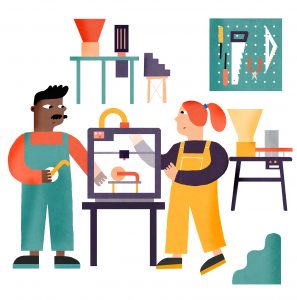
ShareTown is one of the main projects launched by ShareLab, a team active since September 2016. How have Share Lab evolved and what do you imagine in the future?
Initially, our work focused on the collaborative economy and understanding how it is shaping society. The ShareLab fund enabled us to test the use of collaborative platforms to create positive social impact and start to address social needs. We’ve learnt a lot about the challenges and opportunities for these kind of innovative approaches and are now designing a new programme. This programme will seek to work directly with local authorities interested in exploring innovative ways of operating and new ways of working with innovators interested in meeting social needs. We’ll be looking to co-create the a programme with potential participants and will be able to say more about it in the new year. We’re continuing to work with the six innovators who formed the second ShareLab cohort and also with the five Scottish ShareLabbers awarded grants in September. And in February we hope to launch a paper about Platform Coops together with CoopsUK which will help develop (and hopefully accelerate) this concept.
Interview with Jenni Lloyd, December 2018.

